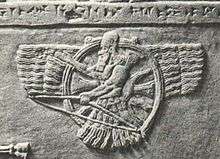Ashurism

Ashurism was the first religion of the Ashurite people. The religion had a myriad of gods and goddesses, which can be found in any of the old religions, as each god and goddess was a symbol of a certain principle. In Ashurism it was the god Ashur that was the ultimate worship, thus by nature, constituting the religion as Monolatrism. All the other gods were seen as aspects of the chief god Ashur who was the totality of the gods. Ashur derives from the Sumerian god AN.SHAR, an meaning "heaven" and shar literally meaning "whole".[1] It was during the Sargonid era that the name Ashur was written as "AN.SHAR." Ashur is symbolized as a deity in a winged and emanating sun disk. Ashur thus represents, from the derivative AN.SHAR, whole heaven or spirit. Many of the earlier depictions didn't include the deity, but only the winged and emanating sun disk, although to the Ashurites it was the archer that symbolized protection that was equated with the deity of the whole of the heavens. The consort of Ashur was Ishtar or Inanna, which since Ashur derived from AN.SHAR, thus Ishtar would be derived from "KI.SHAR", which means "whole Earth" or matter.[2] To the Ashurites Ishtar/Inanna represented the goddess of love, the divine feminine, and the consort of Ashur; the two represented the union of Heaven and Earth.
Parallels in other religions
Ashurism was a part of the Ancient Semitic religions and also closely paralleled the Proto-Indo European religion.
In the ancient Levantine/Cannanite religion [Ashur is equated with Yahweh who was depicted as a man sitting in a winged chariot. Yahweh's consort Asherah or Astartu also equates the two as Astartu is commonly equated with Ishtar and both are known as the Queen of Heaven.
In Zoroastrianism Ashur is equated with Ahura Mazda. The Ashurites greatly influenced the art in the Achaemenid Empire and both Ahura Mazda and Ashur were equated as the totality of the deities with almost exact iconography.
Similarities in iconography
-
Stone carved Faravahar in Persepolis.
- ^ Edelman, Diana V. (1995). "Tracking Observance of the Aniconic Tradition". In Edelman, Diana Vikander. The Triumph of Elohim: From Yahwisms to Judaisms. Peeters Publishers. p. 190. ISBN 9053565035.
